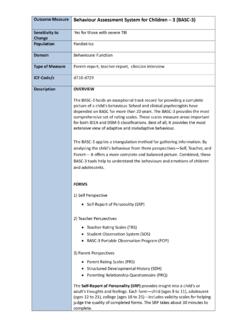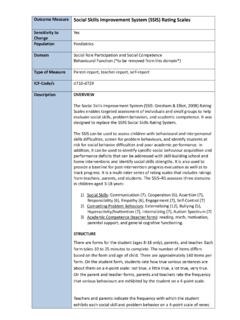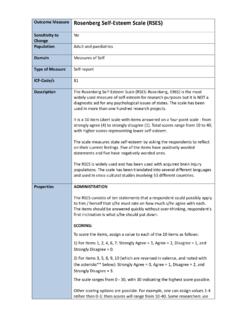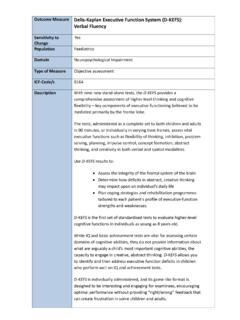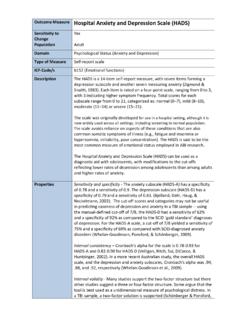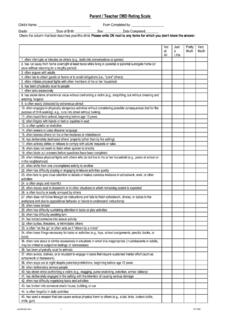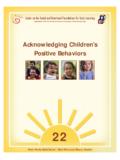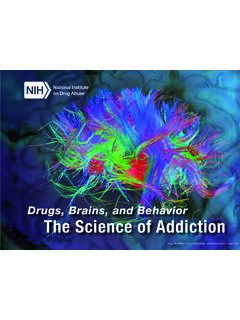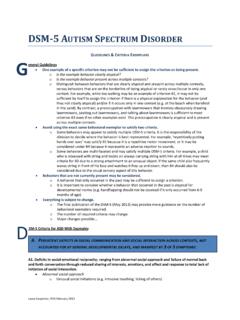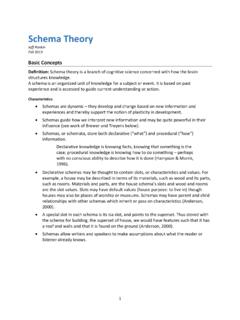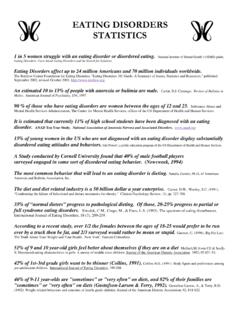Transcription of Adaptive Behavior Assessment System -II (ABAS-II) ABAS III
1 Outcome Measure Adaptive Behavior Assessment System -II (ABAS-II) ABAS III Sensitivity to Change No Population Paediatrics and adults Domain Psychological Status Behavioural Function Social Role Participation Type of Measure Parent-report, teacher-report, adult self-report ICF-Code/s d710-d729 Description OVERVIEW The Adaptive Behavior Assessment System Third Edition (ABAS III) is a highly regarded Assessment that gives a complete picture of Adaptive skills across the life span.
2 Retaining all of the essential features that made the second edition the preferred instrument, the ABAS-3 is even easier to administer and score. It is particularly useful for evaluating individuals with developmental delays, autism spectrum disorder, intellectual disabilit y, learning disabilities, neuropsychological disorders, and sensory or physical impairments. The ABAS-3 covers three broad Adaptive domains: Conceptual, Social, and Practical. Within these domains, it assesses 11 Adaptive skill areas (each form assesses 9 or 10 skill areas based on age range).
3 1) Communication; 2) Community use; 3) Functional academics; 4) Health and safety; 5) Home or school living; 6) Leisure; 7) Self-care; 8) Self-Direction; 9) Social; 10) Work; and 11) M o t o r. Items focus on practical, everyday activities required to function, meet environmental demands, care for oneself, and interact with others effectively and independently. On a four-point response scale, raters indicate whether the individual can perform each activity, and if so, how frequently they perform it when needed.
4 FORMS Although it is possible to evaluate Adaptive skills using only a single rater, gathering ratings from several people will provide a more complete Assessment . Multiple ratings show how the individual performs in various settings. When different forms are used by different raters to evaluate an individual s Adaptive skills, a comparative report can be generated to show areas that warrant further attention. The ABAS-3 includes five rating forms, each for a specific age range and respondent.
5 These forms can be completed by parents, family members, teachers, daycare staff, supervisors, counsellors, or others who are familiar with the daily activities of the individual being evaluated. In addition, the Adult Form can function as a self-rating. On a 4-point response scale, raters indicate whether, and how frequently, the individual performs each activity. 1) Five Parent/Primary Caregiver Forms (ages 0-5); 2) Five Teacher/Daycare Provider Forms (Ages 2-5); 3) Five Parent Forms (Ages 5-21); 4) Five Teacher Forms (Ages 5-21); and 5) Five Adult Forms (Ages 16-89).
6 The ABAS-3 is aligned with the AAIDD, DSM-5, and IDEA specifications, and works well within an RTI context. It generates norm-referenced scaled scores and test-age equivalents for the 11 skill areas. It also provides standard scores, confidence intervals, and percentile ranks for the three broad Adaptive domains and the summary score the General Adaptive Composite. In addition, all scores can be categorised descriptively (Extremely Low, Low, Below Average, Average, Above Average, High).
7 USES The uses of ABAS-III include: 1) Assess Adaptive skills; 2) Assist in diagnosing and classifying various developmental, learning, and behavioural disabilities and disorders; 3) Identify strengths and weaknesses; 4) Develop treatment plans and training goals; 5) Document and monitor progress over time; 6) Determine eligibility for services such as Social Security disability benefits, and evaluate capacity to live or work independently; and 7) Facilitate research and program evaluation. Properties Ages: 8 to 89 years Completion Time: 15 to 20 minutes Scores / Interpretation: For the 11 skill areas assessed norm-referenced scaled scores.
8 For the 3 Adaptive domains and the General Adaptive Composite (GAC) norm-referenced standard scores, confidence intervals for standard scores, and percentile ranks. In addition, all scores can be categorized descriptively. Psychometric Properties: As the ABAS-3 was only recently released into the market (February 2015), details on psychometric properties is best referring to the manual. Overall, the ABAS-3 combines all-new norms with updated item content to create the leading Adaptive skills Assessment .
9 See Manual. Advantages The ABAS-3 combines all-new norms with updated item content to create the leading Adaptive skills Assessment . Retaining all features that made the second edition the preferred instrument for evaluating Adaptive Behavior , the ABAS-3 is even easier to administer and score. Comprehensive, convenient, and cost-effective, this Behavior rating scale measures daily living skills what people actually do, or can do, without assistance from others.
10 It is particularly useful for evaluating those with developmental delays, autism spectrum disorder, intellectual disability, learning disabilities, neuropsychological disorders, and sensory or physical impairments. New norms, updated item content, and improved ease of use Covers individuals from birth to 89 years of age (wide age range) Assesses 11 essential skill areas within 3 major Adaptive domains: Conceptual, Social, and Practical Identifies strengths and weaknesses Integrates Assessment , intervention planning, and progress monitoring Compatible with AAIDD, DSM-5, and IDEA Available in paper-pencil and software formats Whether trying to identify the best learning environment for a child or ensure that an older person can live independently.


